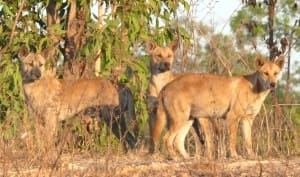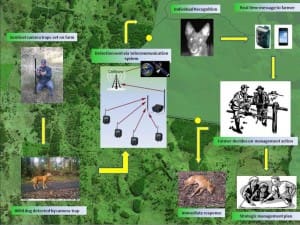 THE world is about to get much smaller for Australia’s wild dogs with the launching today of the $2.5 million Wild Dog Alert project in NSW.
THE world is about to get much smaller for Australia’s wild dogs with the launching today of the $2.5 million Wild Dog Alert project in NSW.
Australia’s first Wild Dog Alert system using facial recognition technology will be field-tested in the project to give landholders first-strike capability against the four-legged livestock predators.
Minister for Agriculture Barnaby Joyce today announced the investment of more than $1 million in the $2.5 million government-industry project.
Launching the project at ‘Eagle Ridge’ outside Walcha, New South Wales, Mr Joyce said the Wild Dog Alert system would use cutting-edge technology, such as automated image recognition software, to get farmers on the front foot in the fight against wild dogs.
The alert system will enable an image of a wild dog to be sent via SMS to farmers in the area, to enable early apprehension and incorporation into regional wild dog location and movement maps.
Tracking studies show that wild dogs may be present on farms for days or weeks before losses occur. Wild Dog Alert will bring together significant developments in automated recognition, remote communication and understanding of wild dog movements to provide proactive management options for livestock producers wherever wild dogs occur.
“Wild dogs cost Australia’s agricultural sector as much as $66 million per year through livestock losses, disease transmission and control costs—and that doesn’t even begin to take into account the emotional impact that wild dog attacks have on farmers.
“An early warning system will help farmers have first strike capability in their fight against wild dogs, so they can be proactive and put in place immediate and targeted management strategies,” Mr Joyce said.
“Each component of the alert system will be tested in the field and as part of this project, wild dogs will also be captured and fitted with GPS trackers so we can learn more about their movement and behaviours.”
The Australian Government is working with project partners, Australian Wool Innovation, and Meat and Livestock Australia ($490,000 combined), NSW Department of Primary Industries ($990,000 in kind) and the University of New England working through the Invasive Animals Cooperative Research Centre, to deliver the project.
Facial recognition technology was the missing piece

This aerial photograph shows an area of public and private land where wild dogs can cause significant livestock losses. Yellow dots show places where holes are made regularly in the dog fence by kangaroos and other animals, allowing wild dogs access to livestock. These are ideal places for Wild Dog Alert sentinel stations.
Invasive Animals CRC chief executive officer Andreas Glanznig said the aim was to integrate the Wild Dog Alert system into regional wild dog mapping efforts, through the Wild Dog Scan and Feral Scan platforms. A Wild Dog Scan app will allow groups of cooperating landholders to receive information about the movements of individual wild dogs within their local area and act together to prevent losses from occurring.
Mr Glanznig said the missing piece in the wild dog “puzzle” was adapting facial recognition technology for dogs, until research by UNE near Walcha identified and tracked a wild dog for several days before it attacked sheep. Combining the FR technology with motion-sensitive cameras means that only a picture of a dog will initiate an image alert to producers and into the regional map.
“This facial recognition technology previously only had military application and we are using extremely smart researchers working in the military space and they have in a sense d-risked the whole process.
“We’re now adapting that technology to have application for producers,” Mr Glanznig said.
The research project will UNE researchers finessing the remote, automated detection and surveillance of wild dogs, integrating into the broader platforms, he said.
“We will be working with a number of farmers and field testing this, because at the end of the day this technology has to be practical and convenient to use.”
It is too early to estimate the approximate cost of a Wild Dog Alert system, he said.
Alert system negates need for GPS tracking
Researcher with the NSW Department of Primary Industries’ Vertebrate Pest Research Unit, Dr Guy Ballard, said the system needed software to recognise dogs and an understanding of where to position detection devices in the landscape.
“To do that, nothing beats having detailed information on the movements of wild dogs and quite a lot of them, so we can understand the variation between different individuals.”
On the question of differentiating a Kelpie from a wild dog, Mr Ballard said “the technology will pick up an animal first of all out of image and then we are moving towards reliable detection of individual dogs – that would be the gold standard.
“But it doesn’t even have to do that to be useful; just recognising a dog and letting a producer know that there is a dog in close proximity to their property or letting a land manager know that there are dogs moving through a patch that is their responsibility will be a huge step forward, save a lot of time and money, and give us proactive opportunities in terms of management,” Dr Ballard said.
“This project will bring together and refine the elements that we need to make automated detection of wild dogs and the real-time alerts for producers and other land managers a reality,” he said.
“If we can recognise dogs in the landscape and detect them at multiple monitoring stations, we don’t actually need that detailed (GPS tracking) information in between.
“All we’ve got to do is let somebody know that a dog is somewhere near where you don’t want a dog right now.”
Producers getting four-fold return on investment
Mr Glanznig said producers are getting a $1 to $4 benefit from federal and state government cash and in-kind funding.
“They are getting a huge dividend.”
Mr Joyce said the Federal Government funding for the Wild Dog Alert system is complemented by $1.63 million we have invested to implement the National Wild Dog Action Plan.
“We have also committed $10 million for pest animal management in last year’s drought assistance package, and have committed an additional $25.8 million in this year’s Budget to continue to manage the impacts of pest animals and weeds in drought-affected areas.
“This investment is essential to the long-term protection of the contribution that our livestock industries make to Australia—wool exports alone were worth $2.9 billion to the national economy in 2013–14.
More information about Wild Dog Alert is available from the Invasive Animals CRC’s website PestSmart Connect www.pestsmart.org.au
Source: Department of Agriculture, Invasive Animals CRC, NSW DPI.

This is about as stupid as it gets.. What absolute nonsense.